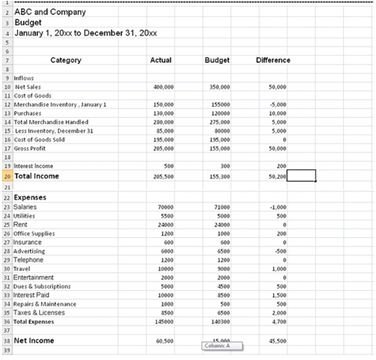Sample Budget Worksheet for Business Use
Creating a budget worksheet for business use is an effective tool for keeping track of income, expenses, and cash flow. A worksheet can be as elaborate as an Excel spreadsheet with formulas and multiple pages, or as simple as a table created on a notepad. Whichever tool is chosen to create the budget, the important thing is to use the budget to help improve the business.
Creating a Budget
A business manager or owner should prepare a budget so he can ensure the business is on track financially. A budget is also an effective tool to determine the necessary expenses of a business, which also determine how much income a business must make to meet these expenses. A budget can be created monthly, quarterly, or annually, depending on the needs of a business. The spreadsheet included with this article is an annual sample budget, but it could be adapted for any time frame.
To access the spreadsheet, click the following link: Sample Budget Worksheet for a Small Business.
Required Sections
A budget worksheet for a business needs to include all monetary occurrences for the business. The sample worksheet details two major areas:
Income is the money the business took in during the budget time frame.
Expenses are what the business paid out during the budgeted time frame. Expenses can include fees paid to attorneys, advertising, utilities, travel expenses, entertaining potential clients, and networking fees.
The worksheet also includes other financial entries such as:
Interest Earned, which is the amount of interest credited to a business’s account, either from interest-earning accounts or from accounts receivables that were paid off using a financing option.
Interest Paid, which is the amount financing cost the business during the budget period.
Cost of Goods Sold****, which is the value of a business’s inventory after sales and purchases.
When the total income and total expenses have been tallied, subtracting the total expenses from total income will produce the Net Income for the business. If the number is positive, the business shows a Net Profit. If the number is negative, that is a Net Loss.
Benefits
A business budget is an effective tool. Comparing the projections with the actual is a good way to determine if business management has a good pulse on how the business operates. It will also highlight errors in budgeting. Using the sample worksheet as an example, Net Sales were projected $50,000 lower than they actually were, while Taxes & Fees were projected too low, creating a $2,000 difference. When creating the next budget, these inaccuracies can be recomputed so the projection and actual are as close in value as possible. Also, after several budgets have been completed, the budgets can be used to track trends, such as peak sale times and the months with the most expenses.
Customization
The table above can be adjusted to meet your business’ needs. For example, if inventory is delivered and the cost of delivery is paid by the company, that would be included as an expense under Cost of Goods Sold. If the company has an online store, then webhosting and design services would be included as expenses. Also, if items do not apply they can be deleted as well.
References
You can also read Tips on How to Estimate your Opening Balance Sheet, also on Bright Hub.
Image credit:
Sample Budget - K.A. Francis
